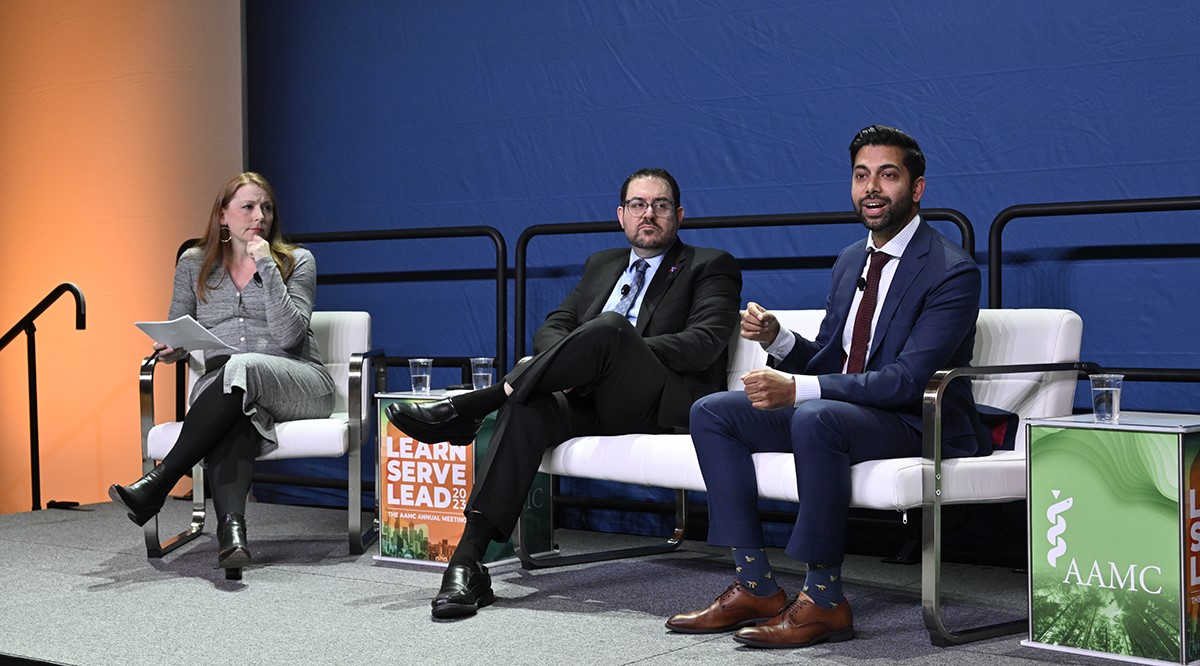
Trauma surgeons Joseph Sakran, MD, center, and Chethan Sathya, MD, right, discuss a public health approach to firearm deaths with violence-prevention expert and moderator Ashley Hink, MD, MPH.
Credit: Kaveh Sardari
For Joseph Sakran, MD, firearm injuries are personal. At 17, a 38-caliber bullet pierced his neck when he was a bystander to gun violence. But they are also personal because of the many fatally injured patients he sees as a trauma surgeon at Johns Hopkins Hospital in Baltimore.
“Despite how good any one of us may be as clinicians, despite how excellent our trauma centers are, if someone comes in shot in the head, there is very little we can do. The best medical treatment for those individuals is really prevention,” he said.
Sakran, together with Chethan Sathya, MD, director of the Center for Gun Violence Prevention at Northwell Health in New York, took the stage on Nov. 4 at Learn Serve Lead 2023: The AAMC Annual Meeting in Seattle to share personal experiences, public policy insights, and guidance for health care leaders hoping to help prevent firearm deaths.
Throughout, they framed gun deaths as a public health issue.
“[We have been working to] transform the lens in how we are looking at this to help people understand that this is a disease,” said Sakran, who launched a medical coalition in 2018 called This Is Our Lane after National Rifle Association comments argued that physicians should not speak out about firearms.
The goal is not to remove firearms from the country, he noted. “We need to think about this the way we talked about car fatalities. ... We didn’t get rid of cars, but we came up with seatbelts and airbags” to increase safety.
The numbers of firearm-related injuries and deaths make clear the need for such efforts, the experts noted.
Every year in the United States, there are more than 48,000 firearm-related deaths. One person is severely injured every 11 minutes. Gun deaths are up 20% since 2019. And firearm injuries are the leading cause of death among children and teens.
But it’s a mistake to lump together all gun deaths, argued Sathya, a pediatric trauma surgeon and firearm injury prevention researcher. Suicides, homicides, and unintentional injuries are all distinct — and therefore require specifically tailored solutions.
In addition, certain communities are much harder hit by gun deaths, the speakers noted in a robust conversation with Ashley Hink, MD, MPH, a trauma surgeon at the Medical University of South Carolina.
“The reality is that every day in cities like Baltimore, Chicago, and Philadelphia, Brown and Black men are being slaughtered on our streets,” said Sakran.
Much work is necessary to help address such tragedies, and academic medicine has a key role to play, the panelists argued.
For one, far too little is known about the true extent and underlying causes of firearm injuries. That’s in part because of funding-related barriers to gun-related research that existed until only recently. In 2019, for the first time in decades, federal funds were allocated for firearm research.
“We definitely made a huge stride for us as a country, but it’s not nearly enough,” said Sathya. “Academic centers need to step up even more to help build on that momentum.”
Physicians can also contribute by screening patients for potential firearm risks. At Northwell, every patient gets screened “even if you come in with a headache or a urinary tract infection,” explains Sathya, who is spearheading and researching the effort.
Screening must include questions about safe gun storage, he noted, given that 4.6 million U.S. children live in homes where guns are unlocked or unsupervised. But it also needs to include screening for exposure to gun violence. Once an institution identifies such concerns, patients can be referred to appropriate supports and resources.
One such resource is Hospital-based Violence Intervention Programs, which offer supportive services including employment counseling, mentoring, and mental health counseling to young people recovering from gun violence. Hink, who launched such an effort at MUSC, explained that staff with personal experience around gun violence “literally wrap arms around these patients.”
Academic medicine also can play a key role by educating future providers about the need to discuss firearms with their patients and providing opportunities to practice the necessary skills and empathy for such conversations. Currently, only about 5% to 8% of providers talk to their patients about firearm safety, Sathya noted.
But providers must also reach far beyond the walls of their hospitals to advocate in the realm of public policy. “Only policy can fix what policy created,” Sakran said.
Effective policies include expanded background checks, child access prevention laws, and requiring licensing and fingerprinting before firearm purchases. Also effective are extreme risk protection orders — commonly known as red flag laws — which allow a judge to require a person who poses a threat to themselves or others to temporarily relinquish their firearms.
All this work may seem overwhelming at times, the experts acknowledged, but it is crucial.
“If we don’t help elevate [this issue], we are going to continue to see the cycles of violence,” said Sakran. But if physicians step off the sidelines, “We have the opportunity to push forward on this in a way that can be unprecedented.”
